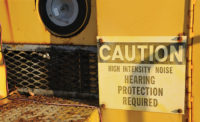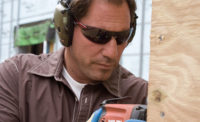I just don't understand,” I heard the safety manager lament. “We offer our noise-exposed workers a variety of hearing protectors, and we monitor the workers to ensure compliance in wearing them. Yet we still had four employees this year with significant shifts in hearing.”
The problem became quite apparent when the safety manager produced samples of the earplugs offered on-site. The "variety" of earplugs touted by the safety manager consisted of two styles, both large foam earplugs from different manufacturers. Any workers with smaller ear canals at the facility – and there were many – would find it difficult to achieve good protection from the “variety” offered.
The false hope that merely supplying earplugs will abate the noise instead often increases the liability for workplace hearing loss, despite meeting the basic requirements of an OSHA-compliant Hearing Conservation Program. Here are case studies from two companies that used fit-testing to measure the protection levels of their noise-exposed workers and to assess the adequacy of their hearing protector offering, and trained workers in obtaining a proper fit.
Oil servicing
An offshore oil platform presents significant safety challenges, but one of the most prevalent is protecting hearing without sacrificing critical communication in fluctuating noise levels. One large company servicing North Sea offshore platforms addressed the challenge by first defining the optimal level of protection. Based on their time-weighted average noise levels, it was determined that adequate protection for all workers could be realized with 16 dB of attenuation. With that clear definition of their goal, the company initiated fit-testing for several hundred of their noise-exposed workers.
Workers were instructed to fit their usual pair of earplugs in the way they were normally worn. On that first “status quo” test, 30 percent of the workers failed to achieve the desired 16 dB of protection. Brief one-on-one training was provided, and in some cases, a different earplug was offered if the original choice was clearly the wrong size. Retesting confirmed the improved protection levels, and 95 percent of the workers were now protected to the desired levels.
For this particular population, nearly all workers were adequately protected with one of just three different models of conventional earplugs (including different sizes). But it was critical to individually test and train each worker to confirm the fit. The documented benefit of the individual fit-training was impressive, as reported in the company's annual health and safety report: “We believe this training will have a positive long-term effect on their behavior in fitting their protectors properly in the future, thus reducing or eliminating noise-induced hearing loss at the worksite.”
Steel mill
With a long-established workforce at this steel rolling mill, there was very little turnover in workers – nor in their hearing protection. Safety managers had supplied the same style of foam earplug to the workers for more than a decade, simply out of routine. But when audiometric data indicated increasing shifts in hearing, the inevitable questions arose: are workers achieving adequate protection, and is the earplug doing its job? A one-day trial of a fit-test system indicated the answer to both questions was no.
It was not difficult to find a safety trainer who would be responsible for the fit-training: a well-respected veteran of the safety staff had already suffered a significant noise-induced hearing loss, and was passionate in his advocacy for good protection among his peers. His first task was to determine whether different earplug sizes and styles would improve the protection levels. Based upon department and job title, each worker was assigned an exposure level between 90 and 105 dBA, and the target protection level was calculated. For some workers, that target protection level was just 10 dB of real protection, while for others, at least 25 dB of protection was required.
Workers were instructed to fit their earplugs as they customarily would, with no coaching or prompting from the safety trainer. A dismal 48% of the 320 workers failed to achieve their minimally-required protection levels, with average protection levels of just 6 dB. But after a brief fit-training session, retests showed a huge improvement: average protection levels rose to 18 dB. One-third of the workers achieved the better results by switching to a different earplug (nearly always a more appropriate size, either larger or smaller); the company adjusted inventory to provide a better "variety" beyond just large foam earplugs. But two-thirds of the workers achieved adequate protection just by fitting their existing earplug better. Each worker walked out of the fit-training session knowing what a good fit feels like and sounds like.
Bottom line
These companies demonstrated very different noise challenges, but the solution was quite similar: define the target protection level for noise-exposed workers, provide fit-testing and training to document real-world protection, and adjust inventory of hearing protectors accordingly.


